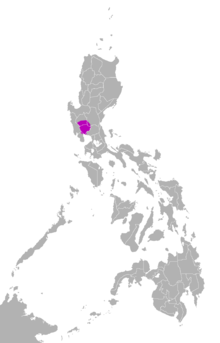Kapampangan language
| Kapampangan | |
|---|---|
| Pampangan | |
| Amánung Kapampangan, Amánung Sísuan | |

"Amanung Sisuan" ("Kapampangan")
in Kapampangan script |
|
| Pronunciation | [kapamˈpaŋan] |
| Native to | Philippines (Central Luzon) |
| Region | Pampanga, southern Tarlac, northeastern Bataan, western Bulacan, southwestern Nueva Ecija and southeastern parts of Zambales |
| Ethnicity | Kapampangan people |
|
Native speakers
|
(1.9 million cited 1990 census) 7th most-spoken native language in the Philippines |
| Dialects | |
|
Latin (Kapampangan alphabet) Historically written in: Kulitan |
|
| Official status | |
|
Official language in
|
Regional language of the Philippines |
| Regulated by | Komisyon sa Wikang Filipino |
| Language codes | |
| ISO 639-2 | |
| ISO 639-3 | |
| Glottolog | pamp1243 |

Kapampangan-speaking area
|
|
The Pampangan language or Kapampangan (Kulitan script: ![]() ) is one of the major languages of the Philippines. It is the language spoken in the province of Pampanga, on the plains of Central Luzon, the southern portion of the province of Tarlac and northeastern Bataan, most of whom belong to the Kapampangan ethnic group. Kapampangan is also understood in some municipalities of Bulacan and Nueva Ecija and by the Aitas or Aeta of Zambales. The language is also called as Pampango and honorifically in the Kapampangan language, as Amánung Sísuan, meaning "breastfed/nurtured language". In 2012, Kapampangan is one of the major languages of the Philippines that is being taught and studied formally in schools and universities.
) is one of the major languages of the Philippines. It is the language spoken in the province of Pampanga, on the plains of Central Luzon, the southern portion of the province of Tarlac and northeastern Bataan, most of whom belong to the Kapampangan ethnic group. Kapampangan is also understood in some municipalities of Bulacan and Nueva Ecija and by the Aitas or Aeta of Zambales. The language is also called as Pampango and honorifically in the Kapampangan language, as Amánung Sísuan, meaning "breastfed/nurtured language". In 2012, Kapampangan is one of the major languages of the Philippines that is being taught and studied formally in schools and universities.
The word Kapampangan is derived from the rootword pampáng which means "riverbank." Historically, this language was used in what was before the Kingdom of Tondo, ruled by the Lakans. In the 18th century, two books were written by Fr. Diego Bergaño about Kapampangan. He authored Vocabulario de la lengua Pampanga and Arte de la lengua Pampanga. Kapampangan produced two literary giants in the 19th century: Father Anselmo Fajardo was noted for his works Gonzalo de Córdova and Comedia Heróica de la Conquista de Granada. Another writer, Juan Crisóstomo Soto, was noted for writing many plays. He authored Alang Dios in 1901. The Kapampangan poetical joust "Crissotan" was coined by his fellow literary genius Nobel Prize nominee for peace and literature in the 50's, Amado Yuzon to immortalize his contribution to Kapampangan literature.
...
Wikipedia
